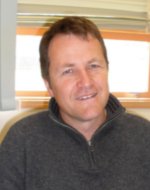Associate Professor Peter Lye
Associate Professor of Chemistry - School of Science and Technology

Phone: +61 2 6773 3018
Email: plye@une.edu.au
Biography
After Dr Lye completed his PhD in the area of inorganic chemistry at the University of Newcastle in 1995 he was appointed as postdoctoral research fellow within the group of Prof. André E. Merbach at the Insitut de Chimie Minéral et Analytique, Université de Lausanne, Lausanne, Switzerland. During this time his research concentrated on the use of both high and ambient pressure stopped-flow techniques in the elucidation of complex reaction mechanisms.
From 1998 - 2002 Dr Lye worked on a number of industrially funded projects (AMIRA Project P497A Cyanide Waste Management and AMIRA Project P420B, Gold Processing Technology) within the A.J. Parker Cooperative Research Centre for Hydrometallurgy at Murdoch University in Perth, WA. The projects were/are supported by a cross-section of Australian, South African and North American gold producing companies (Brokered by the Australian Mineral Industries Research Association Ltd) with my research focusing on the management of cyanide within gold ore processing operations.
In January 2003 he accepted the position of lecturer in Chemistry at the University of New England and maintained his research links with the AJ Parker CRC for Hydrometallurgy through being appointed as Honorary Visiting Researcher In August 2003 and in 2009 was promoted to senior lecturer. He has held the positions of Convenor of Chemistry and Deputy Head of School for Science and Technology, and has held the position of Course Coordinator of the Bachelor of Science since 2015. In 2017 he was made a Fellow of the Royal Australian Chemical Institute.
Qualifications
BSc, PhD (Newcastle (NSW)), GradCertHighEd (NE), CChem, MRACI
Teaching Areas
- Inorganic chemistry
- Environmental chemistry
- Thermodynamics
- Chemical kinetics
Primary Research Area/s
Inorganic; Environmental; and Applied Chemistry.Research Interests
The broad area of research interest is in the study of solution chemistry with particular emphasis on the reaction kinetics and thermodynamics of environmentally and/or industrially important systems.
The following are more specific areas of interest:
- The application of stopped-flow techniques in the elucidation of reaction mechanisms.
- The application of diode array, fibre optic and immersion probe technology for remote sensing applications. This could be either in the laboratory or on-site.
- The effect of high electrolyte concentrations on solution equilibria / dynamics.
- The application of chemometric techniques to complex data analysis from a range systems and instruments and the development of computer programs for the nonlinear least-squares fitting of complex, multivariate chemical measurements, applications in equilibrium and kinetic studies.
- Modelling of complex industrial and environmental systems.
- Supramolecular chemistry in the area of molecular recognition and self assembly.
Publications
Selected publications
A Wallace, M Boerkamp, PG Lye, DW Lamb, WOS Doherty and CM Fellows, Assessment of an Intrinsic Optical Fiber Sensor for in situ Monitoring of Scale-forming Salts, Ind. Eng. Chem. Res., 47(4), pp. 1066-1070, 2008.
M Boerkamp, DW Lamb and PG Lye, Using an intrinsic, exposed core, optical fibre sensor to quantify chemical scale formation, Journal of Physics: Conference Series 76, Sensors and their Applications XIV, doi:10.1088/1742-6596/76/1/012016, 2007.
PG Lye, M Boerkamp, A Ernest and DW Lamb, Investigating the sensitivity of PMMA optical fibres for use as an evanescent field absorption sensor in aqueous solutions, Journal of Physics: Conference Series 15, Sensors and their Applications XIII, pp. 262-269, 2005.
Y Baran, A Bayada, GA Lawrance, PG Lye, M Maeder and EN Wilkes, Comparative stability constants for metal ions with tetraazamacrocycles of various ring sizes carrying a single amine or carboxylate pendant group, Trans. Met. Chem., 28(4), pp. 460-463, 2003.
Christophe Saudan, Frank A. Dunand, Amira Abou-Hamdan, Pascal Bugnon, Peter G. Lye, Stephen F. Lincoln and André E. Merbach, A Model for the Sequential Threading of -Cyclodextrin onto a Guest: A Complete Thermodynamic and Kinetic Study in Water, JACS, 123(42), pp. 10290-10298, 2001.
P. G. Lye, G. A. Lawrance and M. Maeder, Formation Kinetics of Pendant Arm Polyamine Macrocycles with Copper(II), J. Chem. Soc., Dalton Trans., 2376, 2001.
A. Abouhamdan, P. Bugnon, C. Saudan, P. G. Lye and A. E. Merbach, High-pressure studies as a novel approach in determining inclusion mechanisms: Thermodynamics and kinetics of the host-guest interactions for alpha-cyclodextrin complexes, JACS, 122(4), pp.592-602, 2000.
S. Cayemittes, T. Poth, M. J. Fernandez, P. G. Lye, M. Becker, H. Elias and A. E. Merbach, Mechanistic Investigation on the Water Substitution in the p-Arene Complexes [Cp*Ir(H2O)3]2+ and [Cp*Rh(H2O)3]2+, Inorg. Chem., 38, 4309, 1999.
P. G. Lye, G. A. Lawrance and M. Maeder, Complexation of Pendant Arm Macrocycles with Cu(II) Hydroxo Complexes in Strongly Alkaline Solutions. Investigation of pH Dependencies, Inorganic Reaction Mechanisms, Vol. 1, 153, 1999.
P. Bugnon, R. Kissner, P. G. Lye, T. Nauser and W. H. Koppenol, Peroxynitrite Synthesis, Isomerization and Oxidation, Chem. Res. Toxicol., 10, 1285, 1997.

